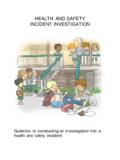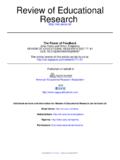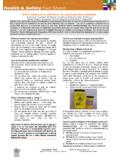Transcription of Capability Framework - Teaching Aboriginal and Torres ...
1 Capability FrameworkTeaching Aboriginal and Torres Strait Islander EAL/D learnersThe Capability Framework supports implementation of the Australian Professional Standards for TeachersDepartment of Education140103_AugArtistElisa Jane Carmichael is a descendant of the Ngugi people, one of the three clan groups of the Quandamooka people of Moreton Bay, Queensland, Australia. We are the people of the sand and seas, Yoolooburrabee. Artwork: The Spirit Net hand-stitched fabric, 2012 The Spirit Net was created when I was travelling throughout India in 2012. I created it while reflecting on my home country and our connections with Mother Earth. The spirit net depicts the movement of our waters, mountains, rocks, deserts and rainforests. It captures the spirit of our land with the spirit of our people today, combining our connections as by Kerry Trapnell, Darren Bell and Nigel Capability Framework Teaching Aboriginal and Torres Strait Islander EAL/D learners is a key deliverable of a project initiated by the Senior Officers National Network of Indigenous Education (SONNIE).
2 The Queensland Department of Education, Training and Employment advises that this document may contain images or references to deceased Aboriginal and Torres Strait Islander peoples from diverse cultural backgrounds and communities. This could be upsetting to some people. The State of Queensland (Department of Education, Training and Employment) 2013 IntroductionQuality Teaching is an important factor in improving education outcomes for Aboriginal and Torres Strait Islander students. Across Australia, many Aboriginal and Torres Strait Islander students come to school speaking languages other than Standard Australian English (SAE). They must develop proficiency in SAE to attain equal access to classroom learning across the curriculum, including achieving in literacy and quality Teaching of these students relies on teachers having knowledge and practice (capabilities) in the education of English as an Additional Language or Dialect (EAL/D) learners including, crucially, Teaching capabilities are described here in the Capability Framework Teaching Aboriginal and Torres Strait Islander EAL/D learners (the Framework ).
3 The Framework is applicable to teachers working in remote, regional and urban contexts across Australia. It was developed to align with and support the Australian Professional Standards for Teachers (APST) and can be used by: teachers to inform practice, self-assess their capabilities and inform professional learning goals principals to inform whole-school practice, determine staff professional learning needs and as support when undertaking performance conversations and assessing teachers against the APST (particularly Strategies for Teaching Aboriginal and Torres Strait Islander students) states and territories to plan and deliver appropriate professional learning opportunities Australian universities to inform content for inclusion in pre-service teacher and postgraduate Framework Teaching Aboriginal and Torres Strait Islander EAL/D learnersAboriginal and Torres Strait Islander EAL/D learnersThere are around 175,000 Aboriginal and Torres Strait Islander students in urban, regional and remote schools across Australia from Arnhem Land in the Northern Territory to Saibai Island in the Torres Strait, from inner city Sydney to the west coast of Western Australia and down to the tip of Tasmania.
4 Aboriginal and Torres Strait Islander students come from rich and diverse family, cultural and language backgrounds. Students have varied life experiences, including living and going to school in the remotest areas of Australia to the busiest areas of major language a child acquires is primarily dependent on the languages spoken by their primary caregivers when they are very young. Although some Aboriginal and Torres Strait Islander children acquire SAE as their first language, the first language of others may be a language or dialect other than SAE, regardless of where they and Torres Strait Islander EAL/D learners are likely to have first languages that are: traditional languages Aboriginal and Torres Strait Islander languages that originated prior to European colonisation, some of which continue to be spoken today creole languages new languages that have formed since colonisation. There are creole languages spoken by Aboriginal and Torres Strait Islander people across Australia Aboriginal English dialects of English spoken by many Aboriginal people across spoken by Aboriginal and Torres Strait Islander people in Australia and varieties of Aboriginal English may superficially resemble Standard Australian English.
5 This can result in students who speak these languages not having their EAL/D learning needs recognised or is important to acknowledge that, although a student may not be proficient in a traditional language, they may strongly identify with one or more traditional languages. The Framework refers to these as heritage languages . 4 Capability Framework Teaching Aboriginal and Torres Strait Islander EAL/D learnersUsing the Framework This Framework is designed so that it can be used independently or alongside the Australian Professional Standards for Teachers (APST). It does not replace the APST. The Framework has seven Capabilities. Each Capability is related to an APST Standard. The Capabilities provide supplementary information for the effective Teaching of Aboriginal and Torres Strait Islander EAL/D the APST, the Capabilities in this Framework are arranged into Domains of Teaching : Professional Knowledge, Professional Practice and Professional Engagement.
6 Framework Capabilities Related Standards from the APST1. Identify Aboriginal and Torres Strait Islander EAL/D learners and understand EAL/D learning1. Know students and how they learn2. Know about language, Standard Australian English, and the language demands of the curriculum2. Know the content and how to teach it3. Plan for and implement effective Teaching and learning for Aboriginal and Torres Strait Islander EAL/D learners3. Plan for and implement effective Teaching and learning4. Create and maintain supportive and safe learning environments for Aboriginal and Torres Strait Islander EAL/D learners4. Create and maintain supportive and safe learning environments5. Assess, provide feedback and report on SAE learning5. Assess, provide feedback and report on student learning6. Engage in professional learning about Teaching Aboriginal and Torres Strait Islander EAL/D learners6. Engage in professional learning7. Develop and engage in respectful and reciprocal cross-cultural relationships7.
7 Engage professionallyProfessional KnowledgeProfessional PracticeProfessional EngagementProfessional KnowledgeProfessional PracticeProfessional EngagementThe following table shows how the Capabilities relate to the APST Standards:5 Capability Framework Teaching Aboriginal and Torres Strait Islander EAL/D learnersThe Capabilities are broken down into Essential Elements (EE). Each EE is named and numbered. The EEs are described at four levels of teacher development: Graduate, Proficient, Highly Accomplished and Lead. These descriptions provide information about the expected growth and development of teachers professional knowledge and practice in each EE. Levels of developmentTeachers may be at different stages of development for different EEs. For example, a teacher may be at a Proficient level for EE 1d (Understand EAL/D Teaching and learning), but may be at a Graduate level for EE 1b (Find out about languages of the school community, including students first languages and heritage languages).
8 Graduate level: Teachers at a Graduate level demonstrate knowledge of and understandings about the EE. In the Framework , Graduate teachers are also beginning to apply this knowledge with support from operating within the Graduate level of a particular EE may be: new teachers who have obtained a Teaching qualification that meets the requirements of a nationally accredited program or initial teacher education course teachers who are new to developing their knowledge and practice in the EE. Proficient level: Teachers at a Proficient level of a particular EE have further developed knowledge and understandings about the EE and are effective in applying this knowledge. Highly Accomplished level: Teachers at a Highly Accomplished level of a particular EE are highly effective, knowledgeable and skilled in the EE. They also contribute to their colleagues learning and level: Teachers at a Lead level of a particular EE have exemplary knowledge and demonstrate consistent and innovative practice within the EE.
9 They contribute significantly to establishing school-wide processes, initiate and lead professional learning, and mentoring others about the EE. The following diagram shows the layout of the Framework . Capability titleEssential ElementRelated Standard and Focus Areas from the Australian Professional Standards for TeachersLevels of teacher development in each Essential ElementDescriptions of teacher development in the Essential ElementsRelevant Domain of Teaching6 Capability Framework Teaching Aboriginal and Torres Strait Islander EAL/D learnersCapability Framework Teaching Aboriginal and Torres Strait Islander EAL/D learnersCapability 1. Identify Aboriginal and Torres Strait Islander EAL/D learners and understand EAL/D learningEssential ElementGraduateProficientHighly AccomplishedLead1a Know about languages spoken by Aboriginal and Torres Strait Islander students across Australia: traditional languages creoles English dialects, Aboriginal awareness of the range of languages spoken by Aboriginal and Torres Strait Islander students across awareness that Aboriginal and Torres Strait Islander languages are legitimate, complex, rule-governed languages.
10 Demonstrate a good understanding about the range of languages spoken by Aboriginal and Torres Strait Islander students across Australia, and the historical and social factors that have influenced high-level knowledge about the range of languages spoken by Aboriginal and Torres Strait Islander students across Australia, and the historical and social factors that have influenced colleagues to learn about the range of languages spoken by Aboriginal and Torres Strait Islander students across Australia. Raise awareness among colleagues that Aboriginal and Torres Strait Islander languages are legitimate, complex and rule-governed languages. Demonstrate high-level knowledge and initiate school-wide professional learning about the range of languages spoken by Aboriginal and Torres Strait Islander students across Australia, and the historical and social factors that have influenced Find out about languages of the school community, including students first languages and heritage awareness of strategies and approaches for finding out about students first languages and, where appropriate, heritage languages.











